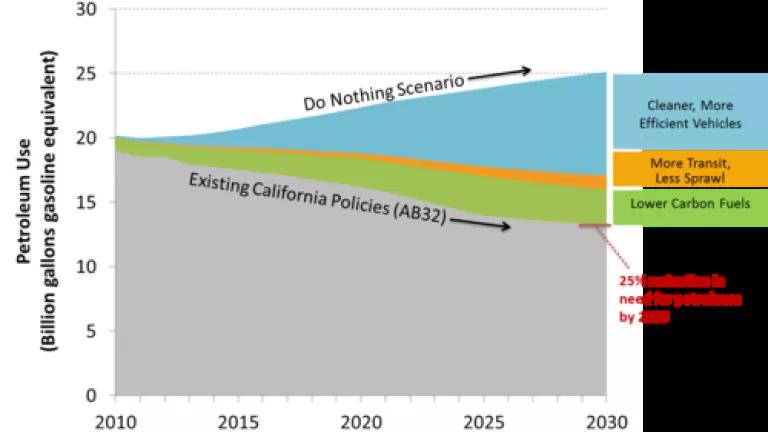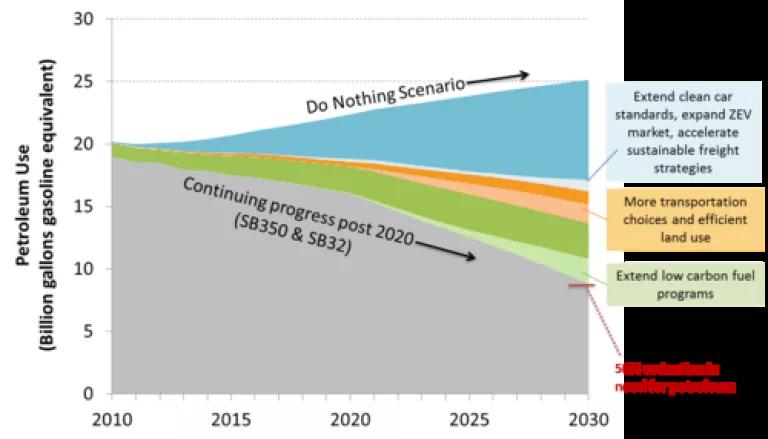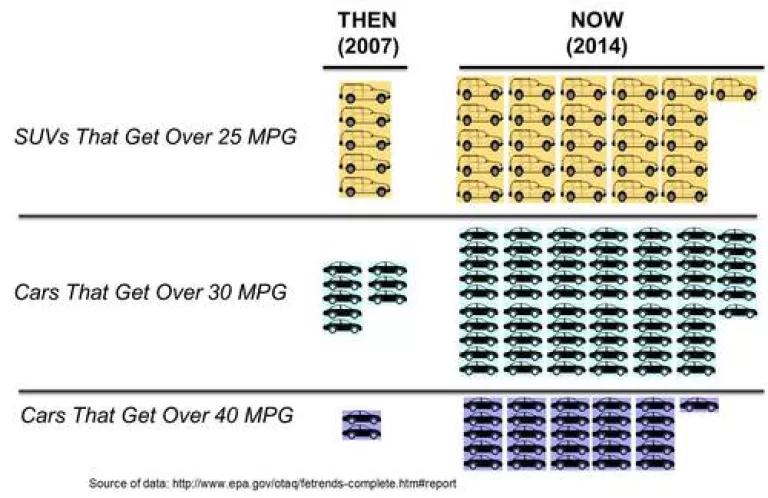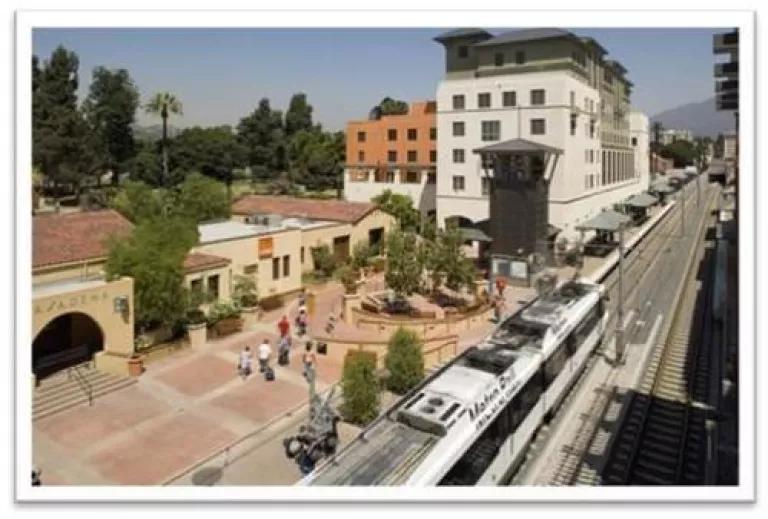
Senate Pro Tem Kevin De León and Governor Jerry Brown, together with a host of other state leaders, have made cutting the state's need for petroleum in half, expanding renewables, and increasing building efficiency core priorities. In doing so, they sent a clear signal to the world that California is going "to build for the future, not steal from it" through clean energy investments.
Now, all eyes are on the California Assembly, which will vote in the next two weeks on SB350 (De León), which would direct state agencies to take steps to cut petroleum use from cars and trucks by 50 percent by 2030 versus current levels, improve energy efficiency and increase renewable energy and SB 32 (Pavley) which will codify climate targets.
Not surprisingly, the oil industry is at it again, with a misleading advertising blitz to protect their bottom line and stop California from moving forward, including using fake, front-groups like "California Drivers Alliance" that has been called out as misleading by David Siders at the Sacramento Bee. Last year NRDC exposed the deception of these front groups in this report. An analytical look reveals convincing technical evidence that California can meet these ambitious, achievable climate goals.
California is already on track to meet over half the target.
Thanks to the clean energy and climate measures established and being implemented under AB32, California's Global Warming Solutions Act of 2006, the state is on track to cut its need for petroleum by at least 25% by 2030, or halfway to the petroleum reduction goals in SB350, shown in the figure below based on our modeling.
California policies can get us the rest of the way.
Reducing our petroleum dependence even more does not require radical, undiscovered breakthroughs in technology. It does mean California needs to accelerate what we are already doing to deploy known technologies, leadership and know-how. As shown below, the additional reductions (lighter shade) are what are needed to get the state the rest of the way, beyond what current clean transportation programs are delivering. By building upon the existing framework and establishing new targets beyond 2020, separate analysis by us here at NRDC and analysis by California Air Resources Board show that continued improvements in vehicle efficiency; deployment of electric-drive cars, trucks and buses; more efficient land use and expanded access to transportation choices; and continued growth in use of clean fuels are key components. These reductions can certainly be achieved in the post 2020 period, but we need to get started now. That's why SB 350 and SB32 are so important.

1. New efficient cars and trucks are already on track to use half the fuel
Thanks to California's historic clean car standards that are now national standards, thanks to President Obama, last year Californians walking into dealerships had 26 passenger car models to choose from that could achieve over 40 miles per gallon (mpg), versus only two models even in 2007. In addition, over the past four years alone, new plug-in electric-drive models have become part of the mix, commonly achieving over 90 miles-per-gallon equivalent.

Under current clean energy policies, the average new vehicles in 2025 will use less than half the amount of fuel compared to those sold in 2007 due to improved technologies. By 2030, under one illustrative scenario California can halve our petroleum dependence with the average passenger car and truck on the road achieving 34 miles per gallon (mpg) instead of about 22 mpg today. New vehicles sold in 2030 would need to achieve just over 50 mpg by 2030, fully in line with the technologies that will be deployed under the new national standards. Fortunately, a June report by the National Academy of Sciences, made up of independent automotive experts, found that automakers are on track to meet the standards in 2025 that will already take us much of the way there. For you gearheads, the infographic below by ANYSIS, Inc (an automotive computer-based engineering simulation company), demonstrates the wide array of technologies today that can help us achieve these levels, ranging from advanced internal combustion engine technologies, to electric-drivetrains, to active aerodynamics. Implementing the program is already saving households today on their gasoline fuel bills - savings that will grow to thousands of dollars annually by 2030.

2. Living closer to work and increasing transportation options
Locating housing closer to jobs, investing in more transportation choices, and creating more walkable communities can reduce commute times, improve the quality of life, and cut pollution. California's Sustainable Communities and Climate Protection Act of 2008, SB 375 (Steinberg), has already enabled regions across the state to begin connecting the dots and to improve land use and transportation decisions in a manner that will cut carbon pollution and petroleum as a co-benefit.

Caltran's latest report, California Transportation Plan 2040, as well as the book Moving Cooler (produced by Cambridge Systematics and the Urban Land Institute), have identified a large array of strategies to increase transportation choices. Some of these include:
- Prioritizing transit investments
- Aligning new housing and job growth and services through mixed land use patterns
- Increasing mobility options such as car sharing, ridesharing, walking, carpooling and telecommuting
- Smarter land use planning that avoids sprawl
- Operational and intelligent transportation systems that better utilizes existing road capacity and reduces congestion
One scenario consistent with meeting California's 50 percent petroleum reduction goal by 2030 would see these strategies implemented, such that the average driver could reduce their time driving by 10% compared to today's level because of more transportation choices and less sprawl. For example, based on San Diego's Sustainable Communities Strategy, residents "will make nearly one-third of their trips in a mode other than, or in addition to, driving" by 2035.
3. Transitioning to a more efficient, sustainable freight system
Many Californians, particularly those in disadvantaged communities, suffer from localized air pollution around major freight corridors. Transitioning to zero-emission technologies and the most efficient freight systems will require an integrated plan to coordinate investments and policies. California is already pursuing efforts to make medium and heavy-duty trucks more clean and efficient within the state in partnership with the federal Environmental Protection Agency and Department of Transportation.
As my colleague Luke Tonachel writes, "In a 2010 study, the National Research Council (NRC) identified technologies to reduce fuel consumption that could be adopted by 2020. Technologies identified in the NRC study and/or the 2014-2018 standards rule-making, together with selected technologies utilized in the Department of Energy's SuperTruck Program, could cost-effectively reduce fuel use by 38 percent, on average, compared to a new 2010 truck." See NRDC's analysis showing how recent innovations make an average fuel savings of 40 percent possible.
Based on NRDC's analysis, cutting our petroleum need in half will mean ensuring those known fuel-efficient technologies are deployed in the state through targeted investments and that stakeholders work together to implement the strategies identified as part of the California Sustainable Freight Strategy.
4. Expanding use of cleaner, lower-carbon fuels
Already, with existing policies such as the state's Low Carbon Fuel Standard (LCFS), the use of alternative fuels such as clean electricity, biogas, and advanced renewable fuels have increased by 20% compared to 2010 and avoided an estimated 11 million metric tons of CO2e (equivalent to the annual emissions from three coal powered plants).
By 2030, one scenario consistent with halving our petroleum need would see our transportation fuel mix further diversified. According to two separate reports (ICCT/E4Tech and Promotum), the LCFS could go even further and triple the use of alternative fuels between the 2025 to 2030 timeframe. Achieving this level of expansion in the clean fuels market would be consistent with halving our need for petroleum by then.
California is already halfway to meeting our 50% petroleum reduction goal. We can make even more progress over next fifteen years.
We are already half way through implementation of the existing AB32 clean energy and climate law and are reaping the benefits. Perhaps the most important reason we need to target halving the need for petroleum and cutting carbon pollution is simply: we must. As Governor Brown eloquently stated:
This is exciting, it is bold and it is absolutely necessary if we are to have any chance of stopping potentially catastrophic changes to our climate system.... We are at a crossroads. With big and important new programs now launched and the budget carefully balanced, the challenge is to build for the future, not steal from it, to live within our means and to keep California ever golden and creative, as our forebears have shown and our descendants would expect.

